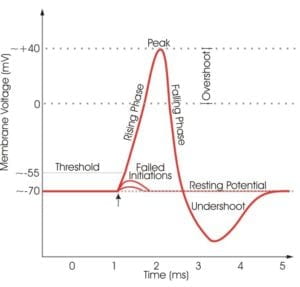When you get down to the details of now artificial neural networks work, they differ from neurons in the human brain. However, the basic concept of how they work is very similar – an unsurprising discovery considering the idea of artificial neural networks was loosely based on how biological nervous systems work.
Both artificial neural networks and brains take inputs, go through some sort of “hidden layer” process, and then return an output. In a convolutional neural network, for example, the input could be an image. After the “hidden layer” process of calculating probabilities is complete, the output is a classification, or category for that image. In a human brain, the input could be touching something very high in temperature. Throughout the “hidden layer” process, neurons and synapses interact with each other which in turn signal you to feel pain as an output.
While this very basic concept may be similar, there are many differences within the “hidden layer” process. Take this graph, for example:

This graph shows the process our human nervous system goes through to produce signals. Cells need a certain amount of membrane voltage in order to transmit a signal; they must be stimulated by their input synapses. This can be related to how in artificial neural networks the input data must be added up before going through a non-linearity. However, neurons follow the all-or-nothing principle: the transferring of signals is binary. With artificial neural networks, the signals are continuous. The amount of power it takes to accomplish tasks also differs: some deep neural networks such as Nvidia GPU requires 300W, whereas our brains only require about 20W of energy.
The learning mechanisms for biological nervous systems and artificial neural networks also differ. Artificial neural networks use gradient descents which take a large amount of data and convert it into a minimum based on a predefined function. On the other hand, while the human brain’s learning process is not entirely known, there is strong evidence for it using Hebbian learning or Spike-Timing-Dependent Plasticity. With these kinds of learning processes, if a set of neurons frequently transmit signals between each other, these connections are made stronger.
As mentioned, there are both similarities and differences between artificial neural networks and human brains. While the details of both are quite different, the inspiration for neural networks still stemmed from biological brains, accounting for the similarities.
Sources:
https://becominghuman.ai/natural-vs-artificial-neural-networks-9f3be2d45fdb’
https://ml4a.github.io/ml4a/convnets/